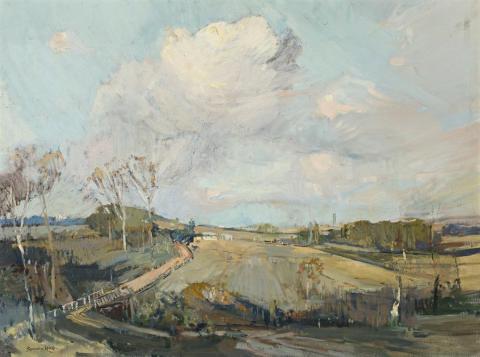AUSTRALIAN LANDSCAPE, c.1940
SYDNEY LONG
oil on canvas
75.5 x 101.0 cm
signed lower left: SYDNEY LONG
bears title on label verso
Sedon Galleries, Melbourne
The David Levine Collection, Melbourne
Sotheby's, Melbourne, 21 April 1986, lot 46
Private collection
Sotheby's, Melbourne, 19 August 1996, lot 235 (as 'The Waterhole')
Private collection, Sydney
The Sydney Long Loan Exhibition, Art Gallery of New South Wales, Sydney, 9 April – 31 May 1941, lent by the artist (label on reverse).
Eagle, M., A Treasury of Australian Art from the David Levine Collection, Rigby, Adelaide, 1981, p. 135 (illus., as 'Australian Landscape')
It was Sydney Long who first taught us to see the tendrilous lines of Art Nouveau in the Australian landscape, populating it with figures from classical mythology. Spirit of the Plains 1897 in the collection of the Queensland Art Gallery was one of his most successful paintings, perhaps equalled by Pan 1898 in the Art Gallery of New South Wales. Peopled with balletic brolgas, nymphs, and fauns, each evokes an enchanting and imaginatively poetic vision of a long bygone age echoing with the ancient sounds of the beguiling pipes of Pan. The birth of time finds its golden age in the Antipodean fields of these large, decorative works, seductive celebrations of Australian Paganism.
While the last two decades of the nineteenth century saw the establishment and development of a distinctly Australian school of painting, they were early times, with artists focusing largely on subjects of bush life and the endeavours of the pioneers. The growing popularity of this brand of nationalism did not embrace the elegance and sophistication of Long's art, although he was not without his admirers. His move to London in 1910 led to an involvement in etching, a medium in which he was particularly gifted. On his return to Australia and eventual residence, etchings gave way to paintings on pastoral themes. 'Many of these later paintings, painted with thick lush layers of oil paint, show the effect of light on water and the reflections of trees. Often these were painted at Narrabeen Lake where he owned a caravan and a strip of land.'1 While our painting eludes exact dating, it belongs to these later years when his decided talent as a landscape painter resulted in him winning two Wynne Prizes - the 1938 prize for Approaching Storm and that of 1940 with The Lake, Narrabeen. One of the particularly attractive features about the painting on offer is the way in which the breadth of handling captures the bold sweep of the view and grandeur of the sky. Rich in textural and atmospheric effects, vestiges of poetic allure linger nostalgically from another era.
1. Mendelssohn, J., Sydney Long, S.H. Ervin Museum and Art Gallery, Sydney, 1979, no pagination
DAVID THOMAS
